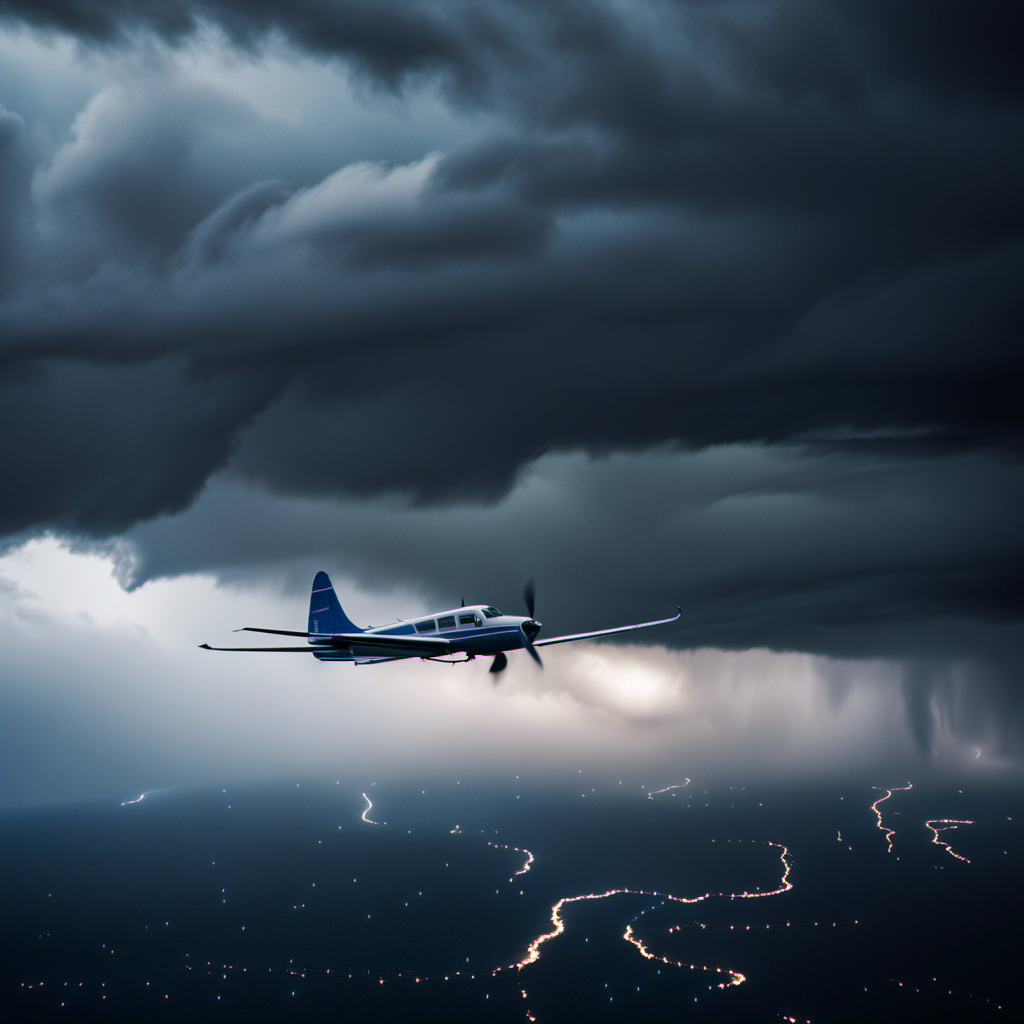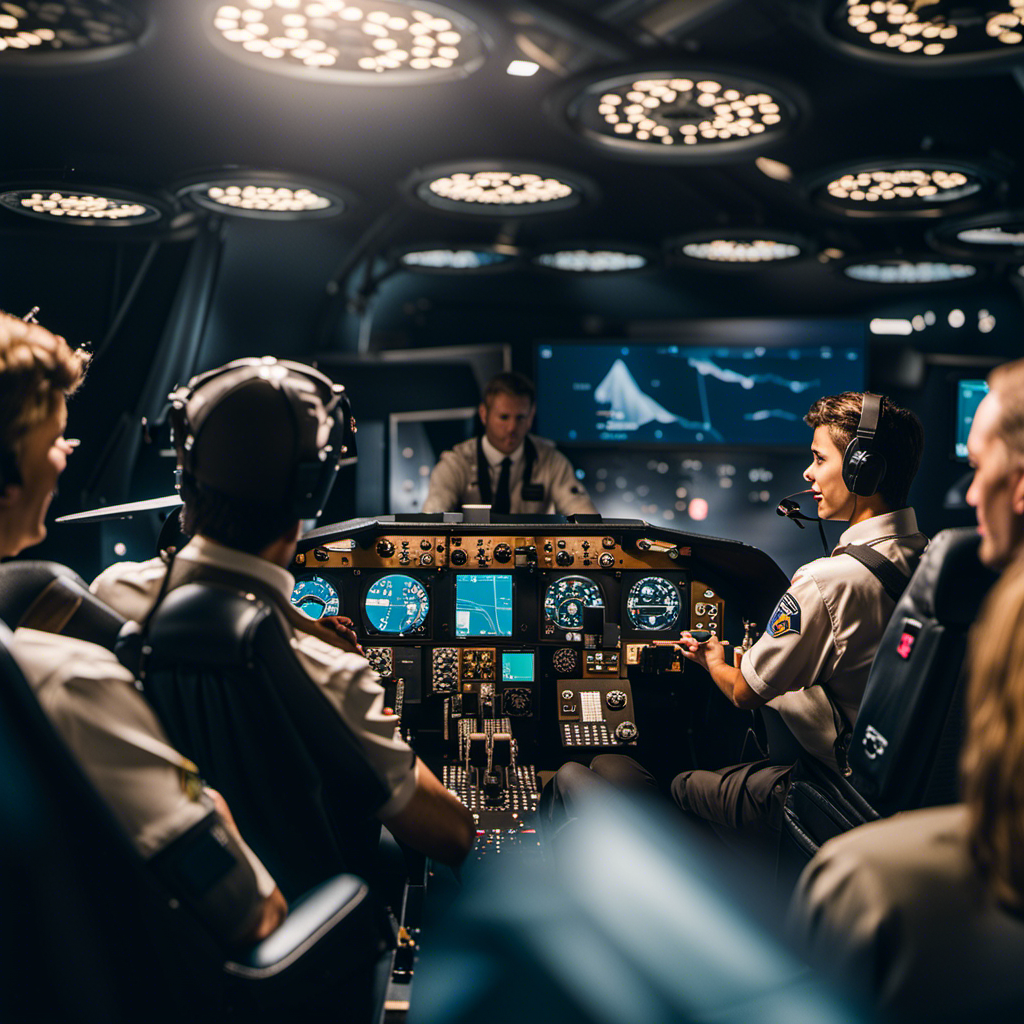As a frequent flyer, I’ve experienced my fair share of stressful moments in the air. But what truly defines the scariest part of air travel?
In this article, we will delve into the various aspects that can induce fear and anxiety during air travel. From the heart-pounding turbulence to the stomach-churning takeoff, we’ll explore the causes behind these fears and provide practical strategies for overcoming them.
So fasten your seatbelts, because we’re about to uncover the truth behind the most dreaded moments in the skies.
Key Takeaways
- Personal perception and fear vary
- Turbulence can be a common fear for many
- Fear of heights or enclosed spaces can contribute to anxiety
- In-flight emergencies can be a source of fear
Turbulence: Understanding the Causes and How to Deal with It
You might be wondering, ‘What causes turbulence and how can you deal with it?’
Turbulence is a common occurrence during flights and can be unsettling for some passengers. Understanding the causes of turbulence can help alleviate fears and provide a sense of control.
There are several factors that contribute to turbulence, including atmospheric conditions, jet streams, and air pockets. Atmospheric conditions such as thunderstorms, cold fronts, and wind shears can create pockets of unstable air, leading to turbulence. Jet streams, which are fast-moving air currents, can also cause turbulence when aircraft encounter them.
Coping strategies for dealing with turbulence include remaining calm and relaxed, fastening your seatbelt securely, and following any instructions given by the flight crew. Additionally, choosing a seat over the wings can minimize the feeling of turbulence. It’s important to remember that turbulence is a normal part of flying and that pilots are trained to navigate through it safely. With this understanding, you can approach turbulence with confidence and ease.
Transitioning into the subsequent section about overcoming the fear of leaving the ground, let’s explore the experience of takeoff and how to manage any anxieties that may arise.
Takeoff: Overcoming the Fear of Leaving the Ground
When it’s time for takeoff, it’s normal to feel a mixture of excitement and nervousness. As someone who used to have a fear of flying, I understand the psychological impact it can have. However, there are ways to overcome this fear and make the experience more enjoyable.
-
Educate yourself: Learning about the physics of flight and how airplanes are designed can help alleviate fears. Understanding the science behind it all can provide reassurance that flying is a safe mode of transportation.
-
Breathing techniques: Deep breathing exercises can help relax the body and calm the mind. Taking slow, deep breaths during takeoff can help reduce anxiety and promote a sense of calm.
-
Distraction techniques: Keeping your mind occupied during takeoff can help redirect your focus away from any fear or anxiety. Listening to music, reading a book, or engaging in conversation with a fellow passenger can all help take your mind off the fear.
Overcoming the fear of takeoff is just one step towards enjoying the flying experience. However, it’s important to address another common fear: the fear of crashing. Examining the statistics and safety measures in place can help provide a better understanding and alleviate this fear.
Fear of Crashing: Examining the Statistics and Safety Measures
Examining the statistics and safety measures can help alleviate fears and provide reassurance when it comes to the fear of crashing. It’s natural to feel anxious about flying, but understanding the facts and regulations can help put our minds at ease. Let’s take a closer look at the statistics analysis and safety regulations surrounding air travel.
| Statistics Analysis | Safety Regulations |
|---|---|
| The chance of being in a plane crash is extremely low. | Airlines must adhere to strict safety protocols. |
| Air travel is statistically safer than driving or even walking. | Aircraft undergo regular maintenance and inspections. |
| The aviation industry continually works to improve safety measures. | Pilots and crew members receive extensive training. |
| Modern aircraft are equipped with advanced technology to prevent accidents. | Airports have emergency plans and procedures in place. |
| Crash investigations help identify and address potential safety issues. | Regulatory bodies enforce safety regulations and conduct audits. |
These statistics and safety measures highlight the commitment of the aviation industry to ensuring passenger safety. By following strict regulations and continuously improving safety protocols, the risk of crashing is minimized.
Transitioning into the subsequent section about ‘the unknown: dealing with anxiety and the fear of the unexpected,’ it’s important to recognize that fear of crashing is just one aspect of the broader fear of flying.
The Unknown: Dealing with Anxiety and the Fear of the Unexpected
Transitioning into the subsequent section about the unknown can help us better understand how to deal with anxiety and the fear of the unexpected.
When it comes to flying, there are many aspects that can trigger panic and uncertainty. Dealing with panic during a flight can be challenging, but there are strategies that can help ease the anxiety.
One effective approach is to focus on deep breathing and relaxation techniques. Taking slow, deep breaths can help calm the nervous system and reduce feelings of panic.
Another helpful technique is to distract oneself with activities such as listening to music or watching a movie. By redirecting the focus away from the fear, it becomes easier to cope with uncertainty.
Additionally, seeking support from a trusted friend or family member can provide reassurance during the flight. Knowing that someone is there to offer comfort and encouragement can make a significant difference in managing anxiety.
Transitioning into the subsequent section about fear of heights: coping strategies for those afraid of flying at high altitudes, we will explore further techniques to overcome this common fear.
Fear of Heights: Coping Strategies for Those Afraid of Flying at High Altitudes
If you’re afraid of heights, coping with the fear during a flight at high altitudes can be challenging, but there are strategies that can help ease your anxiety. Here are some techniques that have been proven effective:
-
Cognitive therapy: This form of therapy focuses on changing negative thought patterns and beliefs associated with flying. By challenging irrational fears and replacing them with more realistic thoughts, cognitive therapy can help you reframe your perspective and reduce anxiety.
-
Breathing exercises: Deep breathing exercises can help calm your nervous system and regulate your heart rate during a flight. Taking slow, deep breaths in through your nose and out through your mouth can activate your body’s relaxation response and alleviate anxiety.
-
Visualization: Picture yourself in a serene and peaceful environment, like a beach or a forest. Engaging in visualization exercises can distract your mind from the fear of heights and create a sense of calmness and tranquility.
-
Distraction techniques: Keep yourself occupied during the flight by engaging in activities that divert your attention away from your fear. Listen to music, watch a movie, or read a book to take your mind off the height and focus on something enjoyable.
By utilizing these coping strategies, you can manage your fear of heights and have a more comfortable flying experience.
Transitioning into the subsequent section about claustrophobia, managing anxiety in the confined space of an airplane, we can explore additional techniques to alleviate anxiety in this specific aspect of flying.
Claustrophobia: Managing Anxiety in the Confined Space of an Airplane
Managing anxiety in the confined space of an airplane can be challenging for individuals with claustrophobia. However, there are techniques that can help alleviate discomfort. Claustrophobia is a specific phobia characterized by the fear of enclosed spaces. For those who experience this condition, being in an airplane cabin can trigger intense anxiety.
There are strategies that can be employed to manage claustrophobia and cope with anxiety while flying. Firstly, it is important to acknowledge and understand your fear. Recognizing that you have claustrophobia and accepting it as a valid feeling can help you rationalize your anxiety.
Breathing exercises can also be beneficial in reducing anxiety symptoms. Deep, slow breaths can help calm your nervous system and promote relaxation. Additionally, distracting yourself during the flight can be helpful. Engaging in activities such as reading, listening to music, or watching a movie can divert your attention away from the confined space.
Fear of Flying Alone: Tips for Solo Travelers to Overcome their Apprehensions
Overcoming the fear of flying alone can be challenging, but there are strategies that solo travelers can utilize to alleviate their apprehensions. As a solo traveler myself, I understand the importance of having support and utilizing fear management techniques to make the experience more comfortable.
One of the first things I recommend is researching and choosing an airline that offers solo traveler support. Some airlines have programs specifically designed to assist solo travelers, offering dedicated staff to guide and support them throughout their journey. Additionally, it can be helpful to inform the flight attendants about your fear of flying alone. They are trained professionals who can offer reassurance and provide any necessary assistance during the flight.
Another strategy is to practice relaxation techniques before and during the flight. Deep breathing exercises, meditation, or listening to calming music can help reduce anxiety and promote a sense of calmness. It can also be beneficial to distract yourself during the flight by engaging in activities such as reading a book, watching a movie, or listening to a podcast.
Transitioning into the next section about in-flight emergencies, it’s important for solo travelers to understand the procedures and safety protocols. By familiarizing themselves with the safety features of the aircraft and listening attentively to the safety instructions provided by the flight attendants, solo travelers can feel more prepared and confident in the event of an emergency.
In-flight Emergencies: Understanding the Procedures and Safety Protocols
During an in-flight emergency, it’s crucial for solo travelers to remain calm and follow the safety protocols provided by the flight attendants. In such situations, understanding the procedures and safety protocols can help alleviate fear and ensure a more secure experience.
Here are some important points to consider:
- The cabin crew is trained to handle various in-flight medical emergencies. They are equipped with first aid kits and are knowledgeable in providing basic medical assistance.
- Flight attendants play a vital role in maintaining order and ensuring the safety of all passengers. They are trained to handle emergency situations and are responsible for communicating important information to passengers.
- It is important to pay attention to the safety demonstrations and familiarize yourself with the location of emergency exits and safety equipment.
- In case of an emergency landing, follow the instructions given by the cabin crew and remain calm. They will guide you through the evacuation process.
Understanding the roles and responsibilities of the cabin crew can help ease anxiety during an in-flight emergency. By remaining calm and following their instructions, solo travelers can ensure their safety and the safety of others on board.
Transition: Now let’s move on to the next section where we will discuss strategies for parents to make the experience of flying with children less stressful.
Fear of Flying with Children: Strategies for Parents to Make the Experience Less Stressful
Transitioning to flying with children can be made less stressful for parents by implementing helpful strategies. Flying with infants and toddlers can be challenging, but with proper preparation and a few tricks up your sleeve, it can become a smoother and more enjoyable experience for everyone involved.
One helpful strategy is to pack a travel bag filled with toys, snacks, and activities to keep your little ones entertained throughout the flight. This will help prevent boredom and minimize tantrums. Additionally, bringing comfort items such as a favorite blanket or stuffed animal can provide a sense of security for your child.
To ensure a comfortable journey, it’s important to dress your children in comfortable clothing and layers in case the cabin temperature fluctuates. Additionally, be prepared for any potential accidents by packing extra diapers, wipes, and a change of clothes.
Here is a table highlighting some key strategies for flying with infants and toddlers:
| Strategies for Flying with Infants and Toddlers |
|---|
| Pack a travel bag with toys, snacks, and activities |
| Bring comfort items for security |
| Dress children in comfortable layers |
| Pack extra diapers, wipes, and a change of clothes |
Overcoming Flight Anxiety: Techniques and Resources for a Smoother Journey
To make your journey smoother, it’s important to utilize techniques and resources that can help alleviate flight anxiety. Here are some techniques and resources that have helped me overcome my own fears and make flying a more enjoyable experience:
-
Deep breathing exercises: Taking slow, deep breaths can help calm your mind and body, reducing anxiety and promoting relaxation.
-
Distraction techniques: Engaging in activities such as reading a book, listening to music, or watching a movie can divert your attention away from anxious thoughts.
-
Positive self-talk: Remind yourself that flying is a safe and routine mode of transportation. Repeat positive affirmations to boost your confidence and reframe any negative thoughts.
-
Seeking support: Consider joining a support group or speaking with a therapist who specializes in anxiety disorders. They can provide valuable guidance and techniques to help manage your flight anxiety.
-
Utilizing technology: There are various apps and online resources available that offer relaxation exercises, guided meditations, and helpful tips for dealing with flight anxiety.
By incorporating these techniques and resources into your pre-flight routine, you can effectively manage and overcome flight anxiety, allowing for a smoother and more enjoyable journey.
Frequently Asked Questions
How do I deal with the fear of flying alone as a solo traveler?
As a solo traveler, it’s common to feel fearful about flying alone. To overcome this fear, it’s important to prioritize safety by choosing reputable airlines, informing loved ones of your travel plans, and distracting yourself with books or movies during the flight.
What are some strategies for managing anxiety in the confined space of an airplane for someone with claustrophobia?
When dealing with claustrophobia on a plane, I use relaxation strategies and coping techniques. Deep breathing, visualization, and focusing on distractions help me manage anxiety in the confined space.
What are the procedures and safety protocols for handling in-flight emergencies?
Procedures and safety protocols for handling in-flight emergencies include crew training, emergency equipment checks, and communication with air traffic control. Passengers are instructed to follow crew instructions and remain calm throughout the situation.
How can parents make the experience of flying with children less stressful?
Preparing children for flying can be stressful, but with these tips, parents can make it easier. According to a study, 71% of parents bring electronic devices to entertain their kids onboard, while 29% opt for coloring books and toys.
What techniques and resources are available for overcoming flight anxiety and having a smoother journey?
To overcome flight anxiety and have a smoother journey, relaxation techniques like deep breathing and visualization can help. Cognitive behavioral therapy is also effective in changing negative thought patterns.
Conclusion
In conclusion, flying can be a daunting experience for many. However, understanding the fears associated with it can help alleviate some of the anxiety.
While turbulence and takeoff may instill a sense of unease, it’s important to remember that flying is statistically one of the safest modes of transportation. By familiarizing yourself with safety measures and coping strategies, you can overcome your fear of the unknown and make your journey more enjoyable.
Remember, the thrill of exploring new heights far outweighs any momentary fright. So, buckle up, embrace the adventure, and soar through the skies with confidence.
With a heart that soars as high as the skies, Aria, affectionately known as “Skylark,” is the driving force behind Soaring Skyways. Her journey into the gliding world began as a young dreamer gazing up at the soaring birds, yearning to experience the weightlessness and freedom they embodied. With years of experience both in the cockpit and behind the scenes, Aria’s commitment to the gliding community is unwavering.










